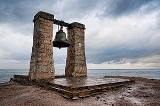
Chersonesos
Encyclopedia

Ancient Greece
Ancient Greece is a civilization belonging to a period of Greek history that lasted from the Archaic period of the 8th to 6th centuries BC to the end of antiquity. Immediately following this period was the beginning of the Early Middle Ages and the Byzantine era. Included in Ancient Greece is the...
colony founded approximately 2,500 years ago in the southwestern part of Crimea
Crimea
Crimea , or the Autonomous Republic of Crimea , is a sub-national unit, an autonomous republic, of Ukraine. It is located on the northern coast of the Black Sea, occupying a peninsula of the same name...
, known then as Taurica
Taurica
Taurica, Tauric Chersonese, and Taurida were names by which the territory of Crimea was known to the Greeks and Romans.- Etymology of the name :...
. The colony was established in the 6th century BC by settlers from Heraclea Pontica
Heraclea Pontica
Heraclea Pontica , an ancient city on the coast of Bithynia in Asia Minor, at the mouth of the river Lycus. It was founded by the Greek city-state of Megara c.560-558 and was named after Heracles who the Greeks believed entered the underworld at a cave on the adjoining Archerusian promontory .The...
.
The ancient city is located on the shore of the Black Sea
Black Sea
The Black Sea is bounded by Europe, Anatolia and the Caucasus and is ultimately connected to the Atlantic Ocean via the Mediterranean and the Aegean seas and various straits. The Bosphorus strait connects it to the Sea of Marmara, and the strait of the Dardanelles connects that sea to the Aegean...
at the outskirts of Sevastopol
Sevastopol
Sevastopol is a city on rights of administrative division of Ukraine, located on the Black Sea coast of the Crimea peninsula. It has a population of 342,451 . Sevastopol is the second largest port in Ukraine, after the Port of Odessa....
on the Crimea
Crimea
Crimea , or the Autonomous Republic of Crimea , is a sub-national unit, an autonomous republic, of Ukraine. It is located on the northern coast of the Black Sea, occupying a peninsula of the same name...
n Peninsula of Ukraine
Ukraine
Ukraine is a country in Eastern Europe. It has an area of 603,628 km², making it the second largest contiguous country on the European continent, after Russia...
, where it is referred to as Khersones. It has been nicknamed the "Ukrainian Pompeii
Pompeii
The city of Pompeii is a partially buried Roman town-city near modern Naples in the Italian region of Campania, in the territory of the comune of Pompei. Along with Herculaneum, Pompeii was destroyed and completely buried during a long catastrophic eruption of the volcano Mount Vesuvius spanning...
" and "Russian Troy
Troy
Troy was a city, both factual and legendary, located in northwest Anatolia in what is now Turkey, southeast of the Dardanelles and beside Mount Ida...
". The site is now part of the National Historical-Archeological Museum-Zapovednik of the Ukrainian Khersones Tavriysky. The name "Chersonesos" in Greek means "peninsula", and aptly describes the site on which the colony was established. It should not be confused with the Tauric Chersonese, the name often applied to the whole of the southern Crimea along with Taurica
Taurica
Taurica, Tauric Chersonese, and Taurida were names by which the territory of Crimea was known to the Greeks and Romans.- Etymology of the name :...
.
During much of the classical period Chersonesus Taurica was a democracy
Democracy
Democracy is generally defined as a form of government in which all adult citizens have an equal say in the decisions that affect their lives. Ideally, this includes equal participation in the proposal, development and passage of legislation into law...
ruled by a group of elected archon
Archon
Archon is a Greek word that means "ruler" or "lord", frequently used as the title of a specific public office. It is the masculine present participle of the verb stem ἀρχ-, meaning "to rule", derived from the same root as monarch, hierarchy, and anarchy.- Ancient Greece :In ancient Greece the...
s and a council called the Damiorgi. As time passed the government grew more oligarchic, with power concentrated in the hands of the archons. A form of oath sworn by all the citizens since the 3rd century BC has survived to the present day.
Antiquity
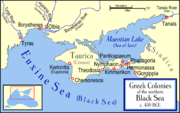
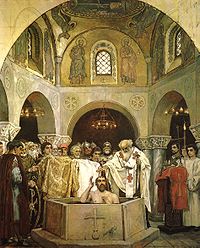
Bosporan Phiale, 4th century BC Satyrus (431 BC - 387 BC), the successor of Spartocus, established his rule over the whole district, adding Nymphaeum to his dominions and laying siege to Theodosia, which was a serious commercial rival because of its ice-free port and proximity to the grain fields of eastern Crimea. It was reserved for his son Leucon (387 BC - 347 BC) to take this city. He was succeeded by his two sons conjointly, Spartocus II, and Paerisades; the former died in 342 and his brother reigned alone until 310. Then followed a civil war in which Satyrus defeated his yonger brother Eumelus at the Battle of the River Thatis in 310 BC but then was killed giving Eumelus the throne.
His successor was Spartocus III (303 BC - 283 BC) and after him Paerisades II. Succeeding princes repeated the family names, but we cannot assign them any certain order. We know only that the last of them, Paerisades V, unable to make headway against the power of the natives, in 108 BC called in the help of Diophantus, general of Mithridates the Great of Pontus, promising to hand over his kingdom to that prince. He was slain by a Scythian named Saumacus who led a rebellion against him.
The house of Spartocus was well known as a line of enlightened and wise princes; although Greek opinion could not deny that they were, strictly speaking, tyrants, they are always described as dynasts. They maintained close relations with Athens, their best customers for the Bosporan grain export, of which Leucon I set the staple at Theodosia, where the Attic ships were allowed special privileges. The Attic orators make numerous references to this. In return the Athenians granted him Athenian citizenship and set up decrees in honour of him and his sons.
In the 1st century BC, after his defeat by Pompey in 63 BC, Mithradates VI (King of Pontus) fled with a small army from Colchis (modern Georgia) over the Caucausus Mountains to Crimea and made plans to raise yet another army to take on the Romans. His eldest living son, Machares, viceroy of Cimmerian Bosporus, was unwilling to aid his father. Mithradates had Machares killed, and Mithradates took the throne of the Bosporan Kingdom. Mithradates then ordered the conscriptions and preparations for war. But in 63 BC, Pharnaces II, his younger son, led a rebellion against his father, joined by Roman exiles in the core of Mithridates' Pontic army. Mithradates withdrew to the citadel in Panticapaeum, where he committed suicide. Pompey the Great buried Mithradates in the rock-cut tombs of his ancestors in Amasia, the old capital of Pontus.
Roman Bosphoran Kingdom
The "Regnum Bosphoranum" during Roman emperor Trajan conquestsMithridates entrusted the Bosporus Cimmerius to his son Machares, who, however, deserted to the Romans. But even when driven out of his own kingdom by Pompey, Mithridates was strong enough to regain the Cimmerian Bosporus, and Machares slew himself. Subsequently the Bosporans again rose in revolt under Pharnaces, another of the old king's sons. After the death of Mithridates (63 BC), this Pharnaces (63 BC - 47 BC) made his submission to Pompey, then tried to regain his dominion during the civil war, but was defeated by Caesar at Zela and later killed by a former governor of his.A pretender, Asander married his daughter Dynamis, and in spite of Roman nominees ruled as archon, and later as king, until 17 BC. After his death, Dynamis was compelled to marry a Roman usurper called Scribonius, but the Romans under Agrippa interfered and set Polemon I of Pontus (16 BC - 8 BC) in his place. Dynamis died in 14 BC and Polemon ruled until 8 BC. After Polemon's death, Tiberius Julius Aspurgus, son of Dynamis and Asander, succeeded Polemon. His Bosphoran kingdom was a "Client State" of the Roman Empire, helped by Roman garrisons.
Ruins of Panticapaeum, modern Kerch, the capital of the Bosporan Kingdom.Tiberius Julius Aspurgus (8 BC - 38) founded a line of kings which endured with certain interruptions until 341 AD. Originally called Aspurgus, he adopted the names "Tiberius Augustus" because he enjoyed the patronage of the first two Roman Emperors, Augustus and Tiberius. All of the following kings adopted these two Roman names followed by a third name, mostly of Pontic and Thracian origin (such as Kotys, Rhescuporis and Rhoemetalces), but also of local origin (such as Sauromates, Eupator, Ininthimeus, Pharsanzes, Synges, Terianes, Theothorses and Rhadamsades).
As the dynasty descended from King Mithridates VI of Pontus through Aspurgus, the kings adopted the "Pontic era" introduced by Mithridates, which started with 297 BC; this era was used to date coins. Bosporan kings struck coinage throughout the kingdom period, which included gold staters bearing portraits of the respective Roman Emperors. However this coinage increasing became debased in the 3rd century. Hence, we know their names and dates fairly well, though scarcely any events of their reigns are recorded. Their kingdom covered the eastern half of Crimea and the Taman peninsula, and extended along the east coast of the Maeotian marshes to Tanais at the mouth of the Don, a great market for trade with the interior.
They carried on a perpetual war with the native tribes, and in this were supported by their Roman suzerains, who even lent the assistance of garrison and fleet. In 63 AD for unknown reasons, the Roman Emperor Nero disposed Cotys (Bosphoran king) from his throne: the Bosporan Kingdom was a Roman Province from 63-68. In 68 AD, the new Roman Emperor Galba had restored the Bosporan Kingdom to Tiberius Julius Rhescuporis I.
At times rival kings of some other races arose and probably produced some disorganization. At one of these periods (255) the Goths and Borani were able to seize Bosporan shipping and raid the shores of Anatolia.
With the coins of the last King Tiberius Julius Rhescuporis VI, in 341 AD, materials for a connected history of the Bosporus Cimmerius come to an end. The kingdom probably succumbed to the Huns, who defeated the nearby Alans in 375/376 AD and moved rapidly westwards bringing destruction in their wake.
In the late 2nd century BC Chersonesus became a dependency of the Bosporan Kingdom
Bosporan Kingdom
The Bosporan Kingdom or the Kingdom of the Cimmerian Bosporus was an ancient state, located in eastern Crimea and the Taman Peninsula on the shores of the Cimmerian Bosporus...
. It was subject to Rome
Roman Empire
The Roman Empire was the post-Republican period of the ancient Roman civilization, characterised by an autocratic form of government and large territorial holdings in Europe and around the Mediterranean....
from the middle of the 1st century BC until the 370s AD, when it was captured by the Huns
Huns
The Huns were a group of nomadic people who, appearing from east of the Volga River, migrated into Europe c. AD 370 and established the vast Hunnic Empire there. Since de Guignes linked them with the Xiongnu, who had been northern neighbours of China 300 years prior to the emergence of the Huns,...
.
Byzantine Era
It became a ByzantineByzantine Empire
The Byzantine Empire was the Eastern Roman Empire during the periods of Late Antiquity and the Middle Ages, centred on the capital of Constantinople. Known simply as the Roman Empire or Romania to its inhabitants and neighbours, the Empire was the direct continuation of the Ancient Roman State...
possession during the Early Middle Ages
Early Middle Ages
The Early Middle Ages was the period of European history lasting from the 5th century to approximately 1000. The Early Middle Ages followed the decline of the Western Roman Empire and preceded the High Middle Ages...
and withstood a siege by the Göktürks
Göktürks
The Göktürks or Kök Türks, were a nomadic confederation of peoples in medieval Inner Asia. Known in Chinese sources as 突厥 , the Göktürks under the leadership of Bumin Qaghan The Göktürks or Kök Türks, (Old Turkic: Türük or Kök Türük or Türük; Celestial Turks) were a nomadic confederation of...
in 581. Byzantine rule was slight: there was a small imperial garrison more for the town's protection than for its control. It was useful to Byzantium in two ways: as an observation point to watch the barbarian tribes, and its isolation made it a popular place of exile for those who angered the Roman and later Byzantine governments. Among its more famous "inmates" were Pope Clement I
Pope Clement I
Starting in the 3rd and 4th century, tradition has identified him as the Clement that Paul mentioned in Philippians as a fellow laborer in Christ.While in the mid-19th century it was customary to identify him as a freedman of Titus Flavius Clemens, who was consul with his cousin, the Emperor...
and Pope Martin I
Pope Martin I
Pope Martin I, born near Todi, Umbria in the place now named after him , was pope from 649 to 653, succeeding Pope Theodore I in July 5, 649. The only pope during the Byzantine Papacy whose election was not approved by a iussio from Constantinople, Martin I was abducted by Constans II and died in...
, and the deposed Byzantine Emperor Justinian II
Justinian II
Justinian II , surnamed the Rhinotmetos or Rhinotmetus , was the last Byzantine Emperor of the Heraclian Dynasty, reigning from 685 to 695 and again from 705 to 711...
. According to Theophanes the Confessor
Theophanes the Confessor
Saint Theophanes Confessor was a member of the Byzantine aristocracy, who became a monk and chronicler. He is venerated on March 12 in the Roman Catholic and the Eastern Orthodox Church .-Biography:Theophanes was born in Constantinople of wealthy and noble iconodule parents: Isaac,...
and others, Chersonesus was the residence of a Khazar governor (tudun) in the late 7th century.
In 833 Emperor Theophilus sent the nobleman Petronas Kamateros, who had recently overseen the construction of the Khazar fortress of Sarkel
Sarkel
Sarkel was a large limestone-and-brick fortress built by the Khazars with Byzantine assistance in the 830s. It was named white-house because of the white limestone bricks they have used to build Sarkel...
, to take direct control over the city and its environs, establishing the theme of Klimata/Cherson
Cherson (theme)
The Theme of Cherson , originally and formally called the Klimata , was a Byzantine theme located in the southern Crimea, headquartered at Cherson....
. It remained in Byzantine hands until the 980s, when it reportedly fell to Kiev
Kiev
Kiev or Kyiv is the capital and the largest city of Ukraine, located in the north central part of the country on the Dnieper River. The population as of the 2001 census was 2,611,300. However, higher numbers have been cited in the press....
. Vladimir the Great agreed to evacuate the fortress only if Basil II
Basil II
Basil II , known in his time as Basil the Porphyrogenitus and Basil the Young to distinguish him from his ancestor Basil I the Macedonian, was a Byzantine emperor from the Macedonian dynasty who reigned from 10 January 976 to 15 December 1025.The first part of his long reign was dominated...
's sister Anna Porphyrogeneta would be given him in marriage. The demand caused a scandal in Constantinople, as imperial princesses had never been married to non-Greeks before. As a pre-condition for the marriage settlement, Vladimir was baptized here in 988, thus paving the way to the Baptism of Kievan Rus'
Baptism of Kievan Rus'
The Christianization of Kievan Rus took place in several stages. In early 867, Patriarch Photius of Constantinople announced to other Orthodox patriarchs that the Rus', baptised by his bishop, took to Christianity with particular enthusiasm...
. Thereafter Korsun' was evacuated.
Since this campaign is not recorded in Greek sources, historians have suggested that this account actually refers to the events of the Rus'-Byzantine War (1043)
Rus'-Byzantine War (1043)
The final Rus'–Byzantine War was, in essence, an ,unsuccessful naval raid against Constantinople instigated by Yaroslav I of Kiev and led by his eldest son, Vladimir of Novgorod, in 1043.The reasons for the war are disputed, as is its course...
and to a different Vladimir
Vladimir of Novgorod
Vladimir Yaroslavich reigned as prince of Novgorod from 1036 until his death. He was the eldest son of Yaroslav I the Wise of Kiev by Ingigerd, daughter of king Olof Skötkonung of Sweden....
. In fact, most valuables looted by the Slavs in Korsun' made their way to Novgorod (perhaps by way of Ioakim Korsunianin, the first Novgorodian bishop, as his surname indicates ties to Korsun), where they were preserved in the Cathedral of Holy Wisdom
Saint Sophia Cathedral in Novgorod
The Cathedral of St. Sophia in the Kremlin in Veliky Novgorod is the cathedral church of the Archbishop of Novgorod and the mother church of the Novgorodian Eparchy.-History:...
until the 20th century. One of the most interesting items from this "Korsun Treasure" is the copper Korsun Gate
Rus'-Byzantine War (1043)
The final Rus'–Byzantine War was, in essence, an ,unsuccessful naval raid against Constantinople instigated by Yaroslav I of Kiev and led by his eldest son, Vladimir of Novgorod, in 1043.The reasons for the war are disputed, as is its course...
, supposedly captured by the Novgorodians in Korsun' and now part of the St. Sophia Cathedral.
After the Fourth Crusade
Fourth Crusade
The Fourth Crusade was originally intended to conquer Muslim-controlled Jerusalem by means of an invasion through Egypt. Instead, in April 1204, the Crusaders of Western Europe invaded and conquered the Christian city of Constantinople, capital of the Eastern Roman Empire...
Chersonesus became dependent on the Empire of Trebizond
Empire of Trebizond
The Empire of Trebizond, founded in April 1204, was one of three Byzantine successor states of the Byzantine Empire. However, the creation of the Empire of Trebizond was not directly related to the capture of Constantinople by the Fourth Crusade, rather it had broken away from the Byzantine Empire...
, and then fell under Genoese
Genoa
Genoa |Ligurian]] Zena ; Latin and, archaically, English Genua) is a city and an important seaport in northern Italy, the capital of the Province of Genoa and of the region of Liguria....
control in the early 13th century. In 1299, the town was sacked by the armies of Nogai Khan
Nogai Khan
Nogai , also called Isa Nogai, was a general and de facto ruler of the Golden Horde and a great-great-grandson of Genghis Khan. His grandfather was Baul/Teval Khan, the 7th son of Jochi...
. A century later it was destroyed by Edigu
Edigu
Edigu was a Mongol emir of the White Horde who founded the new political entity, which came to be known as the Nogai Horde....
and was permanently abandoned. In the late 19th century, St Vladimir's Cathedral
The Vladimir Cathedral in Chersonese
The Saint Vladimir Cathedral is a Neo-Byzantine Russian Orthodox cathedral on the site of Chersonesos Taurica. It commemorates the presumed place of St...
(completed 1892) was built on a small hill overlooking the site; designed in Byzantine style, it was intended to commemorate the site of Vladimir's baptism.
Archaeological site
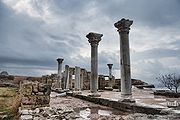
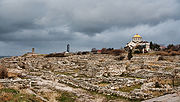
The buildings mix influences of Greek, Roman
Ancient Rome
Ancient Rome was a thriving civilization that grew on the Italian Peninsula as early as the 8th century BC. Located along the Mediterranean Sea and centered on the city of Rome, it expanded to one of the largest empires in the ancient world....
and Byzantine
Byzantium
Byzantium was an ancient Greek city, founded by Greek colonists from Megara in 667 BC and named after their king Byzas . The name Byzantium is a Latinization of the original name Byzantion...
culture. The defensive wall is hundreds of meters long. Buildings include a Roman amphitheatre
Amphitheatre
An amphitheatre is an open-air venue used for entertainment and performances.There are two similar, but distinct, types of structure for which the word "amphitheatre" is used: Ancient Roman amphitheatres were large central performance spaces surrounded by ascending seating, and were commonly used...
and a Greek temple.
The largest portion of the site is "Chora", several square kilometres of ancient but now barren farmland, with remains of wine
Wine
Wine is an alcoholic beverage, made of fermented fruit juice, usually from grapes. The natural chemical balance of grapes lets them ferment without the addition of sugars, acids, enzymes, or other nutrients. Grape wine is produced by fermenting crushed grapes using various types of yeast. Yeast...
presses and defensive tower
Tower
A tower is a tall structure, usually taller than it is wide, often by a significant margin. Towers are distinguished from masts by their lack of guy-wires....
s. According to archaeologists, the evidence suggests that the locals were paid to do the farm work instead of being enslaved
Slavery
Slavery is a system under which people are treated as property to be bought and sold, and are forced to work. Slaves can be held against their will from the time of their capture, purchase or birth, and deprived of the right to leave, to refuse to work, or to demand compensation...
.
The excavated tombstones hint at burial practices that were different from the Greek ones. Each stone marks the tomb of an individual, instead of the whole family and the decorations include only objects like sashes and weapons, instead of burial statues. Over half of the tombs archaeologists have found have bones of children. Burned remnants suggest that the city was plundered and destroyed.
In 2007 Chersonesus tied for fifth in the Seven Wonders of Ukraine
Seven Wonders of Ukraine
The Seven Wonders of Ukraine are the seven historical and cultural monuments of Ukraine, which were chosen in the Seven Wonders of Ukraine contest held in July, 2007...
poll.
On February 13, 2009 Ukrainian Defence Minister
Ministry of Defence (Ukraine)
The Ministry of Defense of Ukraine was established on September 24, 1991, one month after Ukraine's declaration of independence from the Soviet Union. The ministry was in charge of reorganizing all Soviet forces on the Ukrainian terrain under its command...
Yuriy Yekhanurov
Yuriy Yekhanurov
Yuriy Ivanovych Yekhanurov is a Ukrainian politician who was Prime Minister of Ukraine from 2005 to 2006 and Minister of Defense in from 2007 to 2009...
called on Russia's Black Sea naval fleet
Black Sea Fleet
The Black Sea Fleet is a large operational-strategic sub-unit of the Russian Navy, operating in the Black Sea and the Mediterranean Sea since the late 18th century. It is based in various harbors of the Black Sea and the Sea of Azov....
to move its automobile depot from the site to another place. The location of the Russian Black Sea naval fleet's automobile depot is one of the obstacles to the inclusion of the reserve on UNESCO's list of world heritage sites.
Current studies
The Institute of Classical Archaeology of the University of Texas at AustinUniversity of Texas at Austin
The University of Texas at Austin is a state research university located in Austin, Texas, USA, and is the flagship institution of the The University of Texas System. Founded in 1883, its campus is located approximately from the Texas State Capitol in Austin...
and the local Archaeological Park has investigated the site since 1992. The Ukrainian government has included the site on its tentative World Heritage List. The site, however, is in danger of further urban encroachment and coastal erosion
Erosion
Erosion is when materials are removed from the surface and changed into something else. It only works by hydraulic actions and transport of solids in the natural environment, and leads to the deposition of these materials elsewhere...
.
Threats to Chersonesus
The encroachment of modern building in and around the ancient archaeological site, coupled with a lack of funding to prevent such development pressures, has left the site of Chersonesus firmly at risk.In an October 2010 report titled Saving Our Vanishing Heritage
Saving Our Vanishing Heritage
Saving Our Vanishing Heritage: Safeguarding Endangered Cultural Heritage Sites in the Developing World was a report released by Global Heritage Fund on October 17, 2010...
, Global Heritage Fund
Global Heritage Fund
Global Heritage Fund is a non-profit organization that operates internationally. Its mission statement says that it exists to protect and preserve significant and endangered cultural heritage sites in the developing world, through scientific excellence and community development...
identified Chersonesus as one of 12 worldwide sites most "On the Verge" of irreparable loss and destruction, citing insufficient management and development pressures as primary causes.
See also
- List of traditional Greek place names
- Odessa Numismatics Museum having on display coins of Chersonesus
- The bell of Chersonesus
External links
- University of Texas at Austin Institute of Classical Archaeology Chersonesos project
- Bulletin of the Odessa Numismatics Museum
- National Preserve of Tauric Chersonesos, Sevastopol
- Cherson on Regnal Chronologies
- Brief History of Antique Cities of Tauria and Their Coinage.
- Panorams of Chersonesos -
- Photo of Chersonesos -
- High resolution image of antique map of this region
- Explore Chersonesos with Google Earth on Global Heritage NetworkGlobal Heritage NetworkGlobal Heritage Network , established by Global Heritage Fund , is an early warning and threats monitoring system for cultural heritage sites in developing countries...

